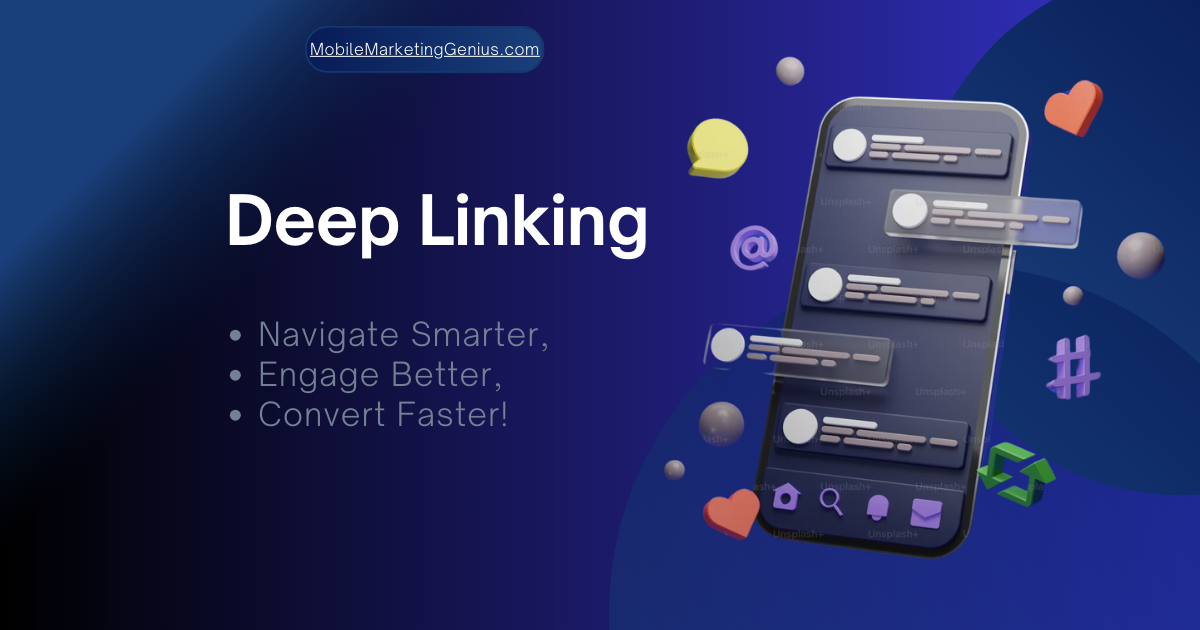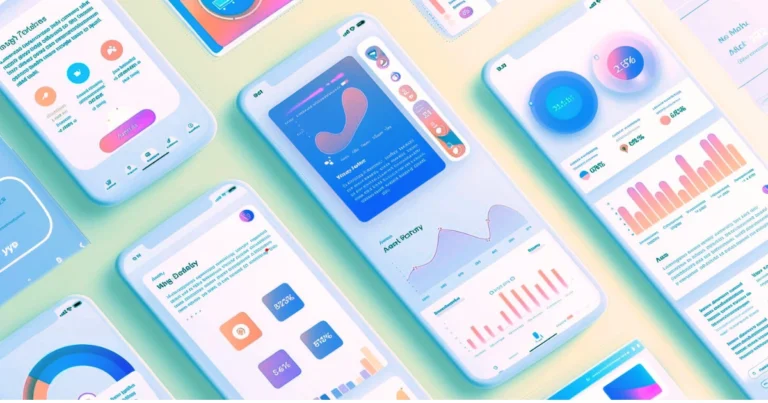What is Deep Linking: Transform Your App Experience with Smarter Navigation

Seamless navigation in today’s digital world, seamless navigation is key to improving user experience and engagement. One powerful tool that addresses this need is deep linking. But what is deep linking, and why does it matter? Simply put, deep linking is a method that directs users to specific content within an app or a website, bypassing generic landing pages. This targeted approach is essential for app marketers, as it ensures that users land exactly where they need to, increasing the likelihood of conversions and interactions.
For instance, imagine tapping a link in an email and being taken directly to a product page in an app instead of the homepage. That’s deep linking in action. This article explores what is a deep link, how it works, and why it’s indispensable for modern marketing efforts. We’ll delve into its benefits, real-world use cases, best practices, and strategic placement tips to help you harness its full potential.
Table of Contents
What is Deep Linking? How Does Deep Linking Work?
At its core, deep linking refers to the use of a hyperlink that directs users to a specific location within a mobile app or a webpage. Unlike traditional links that lead to a generic homepage, deep links streamline navigation by taking users straight to the content they’re looking for. But what is a deep link, and how does it work?
There are three main types of deep links:
- Basic Deep Links: These require the app to be installed and route users to specific app content. For example, when a user clicks on a basic deep link, the system checks if the app is already installed. If it is, the link directly opens the app and navigates to the specified content, such as a product page, user profile, or specific feature. However, basic deep links will not work if the app isn’t installed on the user’s device, limiting their functionality.
- Deferred Deep Links: These links are more flexible as they work even if the app isn’t installed. When a user clicks a deferred deep link, they are redirected to the app store to download the app. Once installed, the app opens directly to the intended content rather than the default homepage. This functionality is particularly useful for onboarding new users and ensuring a smooth experience from the initial interaction to app usage.
- Contextual Deep Links: These are the most advanced type, carrying additional user-specific information to personalize the experience. For instance, a contextual deep link can include details like a referral code, promotional offer, or user preferences, which are passed into the app upon opening. This makes it possible to provide a tailored experience post-click, enhancing user satisfaction and engagement.
Contextual deep links have shown a 2x improvement in user retention rates (Source: Branch.io).
Deferred deep links can improve app downloads by up to 30% (Source: AppsFlyer).
From a technical perspective, deep linking relies on URL schemes and intent filters that instruct devices on where to route users. Modern tools like firebase dynamic links make implementing these links seamless, enabling robust cross-platform compatibility.
With mobile deep linking, app developers can ensure a more efficient user journey, a feature that makes deep links important for app usability. Moreover, app marketers can leverage linking deep to optimize engagement and retention strategies effectively. If you need to adjust deep linking, these tools offer flexibility and ease of use.
The Benefits of Effective Deep Links
Why are deep links important for app marketers? The answer lies in their ability to enhance the user experience while driving measurable business outcomes. Here are some of the key benefits:
- Improved User Experience: By cutting down the steps required to reach desired content, deep links make navigation intuitive and hassle-free.
- Higher Conversion Rates: Guiding users directly to product pages or promotional offers increases the likelihood of immediate actions such as purchases or sign-ups.
- Increased Retention and Engagement: With features like mobile deep links important, re-engaging dormant users becomes easier through targeted notifications or email campaigns.
- Enhanced Marketing Campaigns: Deep links allow for precise tracking of user behavior and campaign performance, giving marketers valuable insights. Tools like firebase dynamic links can further simplify this process.
- SEO and App Indexing: Deep linking supports app indexing, ensuring apps appear in search results and driving organic traffic.
By addressing these benefits, marketers can see why deep links for your app are integral to modern marketing strategies. Their ability to integrate with cross-channel campaigns makes links important for app marketers aiming for long-term success.
Use Cases of Deep Linking in the Real World
Deep linking isn’t just a technical feature—it’s a practical tool with diverse applications. Here are some real-world examples where mobile deep linking proves invaluable:
- E-commerce: Direct users to specific products or promotional deals within an app, bypassing unnecessary navigation.
- Social Media and Content Sharing: Allow users to share specific app content, like posts or videos, with friends through linking deep.
- Onboarding New Users: Deferred deep links can guide new users to the app store, download the app, and directly open the content they were interested in.
- Travel and Hospitality: Provide users with direct access to booking details, itineraries, or hotel reviews through links.
- Gaming: Unlock special levels, rewards, or in-app purchases directly using deep links for your app.
- Education and eLearning: Take learners to specific modules, courses, or assessments using firebase dynamic links.
These examples highlight how deep links important for app usability extend beyond functionality. By offering value to users, these links drive engagement and loyalty while making navigation effortless.
The Benefits of Effective Deep Links
Why are deep links important for app marketers? The answer lies in their ability to enhance the user experience while driving measurable business outcomes. Here are some of the key benefits:
- Improved User Experience: By cutting down the steps required to reach desired content, deep links make navigation intuitive and hassle-free. Studies show that 85% of users prefer apps with seamless navigation experiences (Source: Statista).
- Higher Conversion Rates: Guiding users directly to product pages or promotional offers increases the likelihood of immediate actions such as purchases or sign-ups.
- Increased Retention and Engagement: With features like mobile deep links important, re-engaging dormant users becomes easier through targeted notifications or email campaigns.
- Enhanced Marketing Campaigns: Deep links allow for precise tracking of user behavior and campaign performance, giving marketers valuable insights. Tools like firebase dynamic links can further simplify this process.
- SEO and App Indexing: Deep linking supports app indexing, ensuring apps appear in search results and driving organic traffic.
By addressing these benefits, marketers can see why deep links for your app are integral to modern marketing strategies. Their ability to integrate with cross-channel campaigns makes links important for app marketers aiming for long-term success.
Use Cases of Deep Linking in the Real World
Deep linking isn’t just a technical feature—it’s a practical tool with diverse applications. Here are some real-world examples where mobile deep linking proves invaluable:
- E-commerce: Direct users to specific products or promotional deals within an app, bypassing unnecessary navigation.
- Social Media and Content Sharing: Allow users to share specific app content, like posts or videos, with friends through linking deep.
- Onboarding New Users: Deferred deep links can guide new users to the app store, download the app, and directly open the content they were interested in.
- Travel and Hospitality: Provide users with direct access to booking details, itineraries, or hotel reviews through links.
- Gaming: Unlock special levels, rewards, or in-app purchases directly using deep links for your app.
- Education and eLearning: Take learners to specific modules, courses, or assessments using firebase dynamic links.
These examples highlight how deep links important for app usability extend beyond functionality. By offering value to users, these links drive engagement and loyalty while making navigation effortless.
Best Practices for Meaningful Results
For deep linking to deliver optimal results, it’s essential to follow best practices. Here’s how to set deep links for your app effectively:
- Prioritize User Intent: Understand user behavior and design links that align with their journey.
- Ensure Cross-Platform Compatibility: Use tools like firebase dynamic links to make deep links work seamlessly across iOS, Android, and web platforms.
- Test Thoroughly: Broken or misdirected links can harm user experience. Regular testing ensures links remain functional.
- Track Performance: Incorporate analytics to monitor how users interact with your links. This data helps refine strategies.
- Leverage Personalization: Use contextual deep links to deliver tailored content based on user preferences.
- Maintain Link Integrity: Ensure that all mobile deep linking structures are up-to-date and functional.
- Adjust Deep Linking Strategies**: Regularly review and refine your deep linking setup to match changing user needs and technological advancements.
By following these practices, marketers can address marketers how do you set deep links for maximum effectiveness and engagement.
Strategic Placement of Deep Links
Where you place your deep links matters as much as how you implement them. Strategic placement can maximize their effectiveness and deliver higher ROI. Here are some suggestions:
- Marketing Campaigns: Embed deep links in emails, social media posts, and SMS campaigns to drive targeted traffic.
- Push Notifications: Use personalized notifications with mobile deep links important to guide users to specific app features or content.
- In-App Banners and Pop-Ups: Encourage navigation within the app using linking deep techniques.
- SEO Strategies: Combine deep linking with app indexing for better visibility in search engines.
- Offline Media: Integrate QR codes with firebase dynamic links to connect offline and online experiences seamlessly.
- Adjust Deep Linking Placement**: Evaluate user behavior to refine where and how deep links are integrated into your campaigns.
Strategic placement ensures that deep links important for app marketers are utilized effectively, creating a frictionless experience for users while achieving marketing objectives.
Conclusion
Deep linking is more than just a technical innovation—it’s a vital strategy for improving user experience and achieving business goals. Understanding what is deep linking, how it works, and its real-world applications can help marketers unlock its full potential. By adopting best practices and placing links strategically, businesses can ensure that deep links for your app deliver meaningful results.
Tools like firebase dynamic links make implementing these strategies easier, while analytics enable continuous improvement. As links important for app marketers evolve, mastering deep linking will remain essential for creating seamless and impactful user journeys. Whether you’re guiding users to content or re-engaging them with targeted campaigns, deep linking is your key to success.






